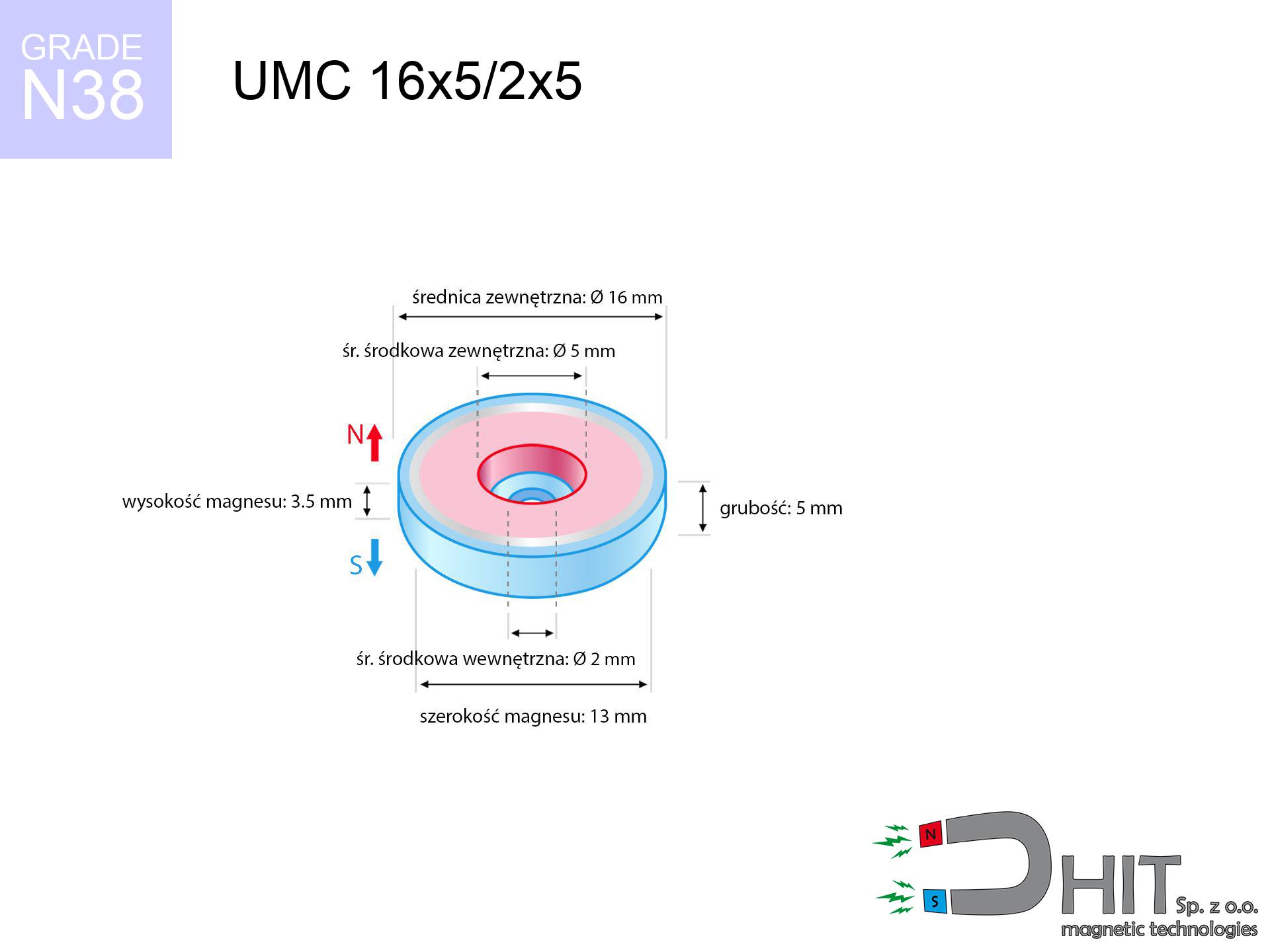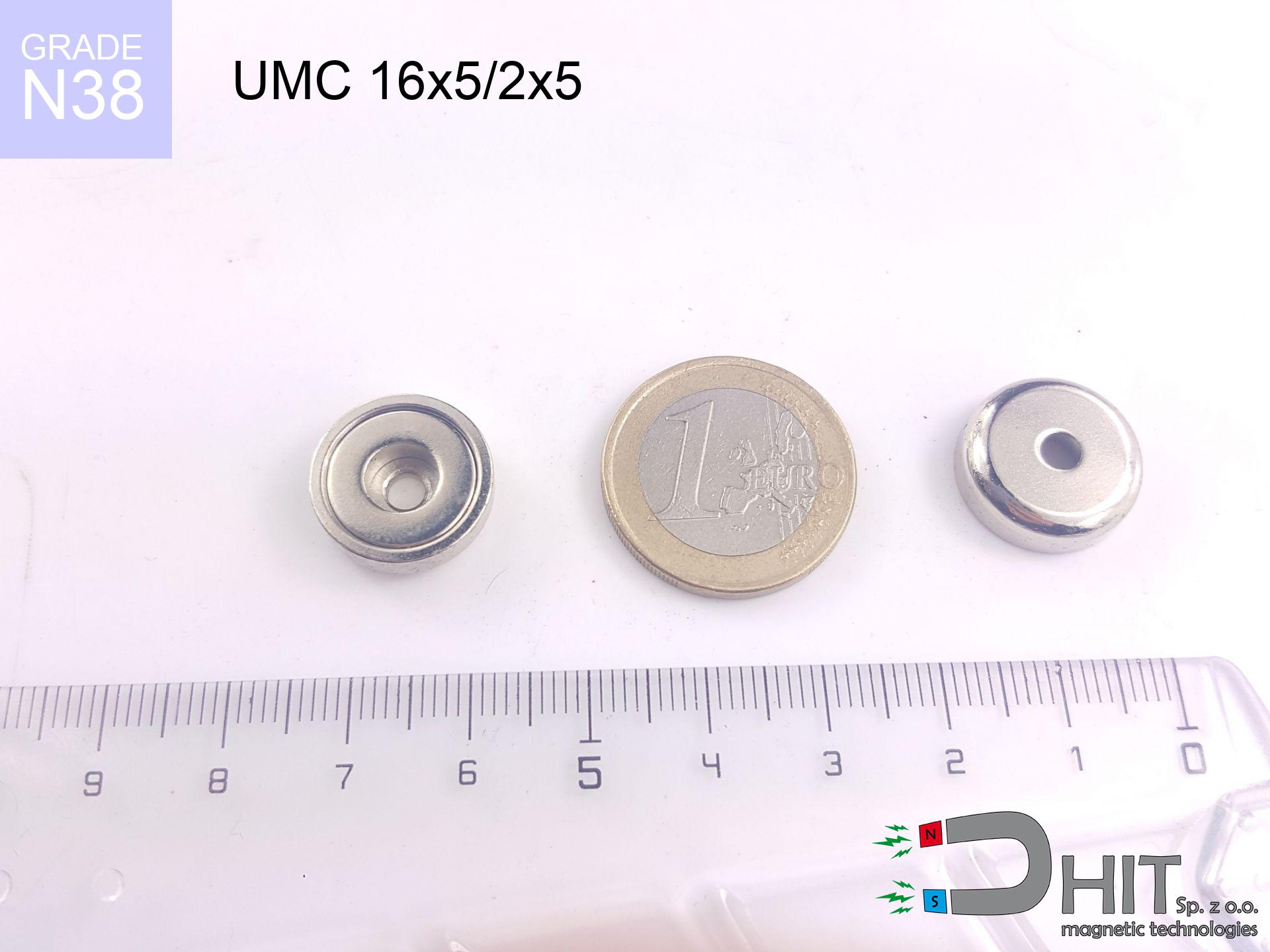UMC 16x5/2x5 / N38 - cylindrical magnetic holder
cylindrical magnetic holder
Catalog no 320406
GTIN/EAN: 5906301814627
Diameter
16 mm [±1 mm]
internal diameter Ø
5/2 mm [±1 mm]
Height
5 mm [±1 mm]
Weight
5.5 g
Load capacity
4.00 kg / 39.23 N
Coating
[NiCuNi] Nickel
3.33 ZŁ with VAT / pcs + price for transport
2.71 ZŁ net + 23% VAT / pcs
bulk discounts:
Need more?
Call us now
+48 22 499 98 98
alternatively send us a note via
contact form
the contact form page.
Parameters and form of a neodymium magnet can be tested with our
online calculation tool.
Same-day shipping for orders placed before 14:00.
Technical specification - UMC 16x5/2x5 / N38 - cylindrical magnetic holder
Specification / characteristics - UMC 16x5/2x5 / N38 - cylindrical magnetic holder
| properties | values |
|---|---|
| Cat. no. | 320406 |
| GTIN/EAN | 5906301814627 |
| Production/Distribution | Dhit sp. z o.o. |
| Country of origin | Poland / China / Germany |
| Customs code | 85059029 |
| Diameter | 16 mm [±1 mm] |
| internal diameter Ø | 5/2 mm [±1 mm] |
| Height | 5 mm [±1 mm] |
| Weight | 5.5 g |
| Load capacity ~ ? | 4.00 kg / 39.23 N |
| Coating | [NiCuNi] Nickel |
| Manufacturing Tolerance | ±1 mm |
Magnetic properties of material N38
| properties | values | units |
|---|---|---|
| remenance Br [min. - max.] ? | 12.2-12.6 | kGs |
| remenance Br [min. - max.] ? | 1220-1260 | mT |
| coercivity bHc ? | 10.8-11.5 | kOe |
| coercivity bHc ? | 860-915 | kA/m |
| actual internal force iHc | ≥ 12 | kOe |
| actual internal force iHc | ≥ 955 | kA/m |
| energy density [min. - max.] ? | 36-38 | BH max MGOe |
| energy density [min. - max.] ? | 287-303 | BH max KJ/m |
| max. temperature ? | ≤ 80 | °C |
Physical properties of sintered neodymium magnets Nd2Fe14B at 20°C
| properties | values | units |
|---|---|---|
| Vickers hardness | ≥550 | Hv |
| Density | ≥7.4 | g/cm3 |
| Curie Temperature TC | 312 - 380 | °C |
| Curie Temperature TF | 593 - 716 | °F |
| Specific resistance | 150 | μΩ⋅cm |
| Bending strength | 250 | MPa |
| Compressive strength | 1000~1100 | MPa |
| Thermal expansion parallel (∥) to orientation (M) | (3-4) x 10-6 | °C-1 |
| Thermal expansion perpendicular (⊥) to orientation (M) | -(1-3) x 10-6 | °C-1 |
| Young's modulus | 1.7 x 104 | kg/mm² |
Material specification
| iron (Fe) | 64% – 68% |
| neodymium (Nd) | 29% – 32% |
| boron (B) | 1.1% – 1.2% |
| dysprosium (Dy) | 0.5% – 2.0% |
| coating (Ni-Cu-Ni) | < 0.05% |
Sustainability
| recyclability (EoL) | 100% |
| recycled raw materials | ~10% (pre-cons) |
| carbon footprint | low / zredukowany |
| waste code (EWC) | 16 02 16 |
See more proposals
Advantages and disadvantages of Nd2Fe14B magnets.
Benefits
- They virtually do not lose power, because even after ten years the performance loss is only ~1% (according to literature),
- They are extremely resistant to demagnetization induced by external field influence,
- The use of an elegant coating of noble metals (nickel, gold, silver) causes the element to look better,
- Magnets are distinguished by maximum magnetic induction on the outer side,
- Made from properly selected components, these magnets show impressive resistance to high heat, enabling them to function (depending on their shape) at temperatures up to 230°C and above...
- Thanks to versatility in constructing and the capacity to adapt to specific needs,
- Key role in future technologies – they are utilized in mass storage devices, motor assemblies, precision medical tools, as well as complex engineering applications.
- Compactness – despite small sizes they offer powerful magnetic field, making them ideal for precision applications
Cons
- At very strong impacts they can crack, therefore we advise placing them in strong housings. A metal housing provides additional protection against damage, as well as increases the magnet's durability.
- NdFeB magnets demagnetize when exposed to high temperatures. After reaching 80°C, many of them experience permanent weakening of power (a factor is the shape as well as dimensions of the magnet). We offer magnets specially adapted to work at temperatures up to 230°C marked [AH], which are very resistant to heat
- Magnets exposed to a humid environment can rust. Therefore when using outdoors, we suggest using water-impermeable magnets made of rubber, plastic or other material protecting against moisture
- We recommend casing - magnetic holder, due to difficulties in producing nuts inside the magnet and complex shapes.
- Potential hazard to health – tiny shards of magnets can be dangerous, if swallowed, which becomes key in the context of child safety. Additionally, tiny parts of these magnets can complicate diagnosis medical when they are in the body.
- Due to neodymium price, their price exceeds standard values,
Holding force characteristics
Breakaway strength of the magnet in ideal conditions – what it depends on?
- using a plate made of low-carbon steel, serving as a magnetic yoke
- whose transverse dimension reaches at least 10 mm
- with an ideally smooth touching surface
- with total lack of distance (without paint)
- during pulling in a direction vertical to the plane
- at temperature approx. 20 degrees Celsius
Practical lifting capacity: influencing factors
- Space between surfaces – even a fraction of a millimeter of distance (caused e.g. by varnish or unevenness) drastically reduces the magnet efficiency, often by half at just 0.5 mm.
- Load vector – highest force is obtained only during perpendicular pulling. The shear force of the magnet along the plate is usually several times lower (approx. 1/5 of the lifting capacity).
- Element thickness – for full efficiency, the steel must be adequately massive. Thin sheet restricts the lifting capacity (the magnet "punches through" it).
- Material type – the best choice is high-permeability steel. Cast iron may generate lower lifting capacity.
- Surface condition – ground elements ensure maximum contact, which improves field saturation. Uneven metal reduce efficiency.
- Thermal environment – temperature increase causes a temporary drop of force. It is worth remembering the thermal limit for a given model.
Lifting capacity was measured by applying a steel plate with a smooth surface of optimal thickness (min. 20 mm), under perpendicular detachment force, however under parallel forces the holding force is lower. In addition, even a minimal clearance between the magnet and the plate reduces the lifting capacity.
Warnings
Fire warning
Fire hazard: Rare earth powder is explosive. Avoid machining magnets without safety gear as this risks ignition.
Finger safety
Large magnets can smash fingers instantly. Never place your hand betwixt two attracting surfaces.
Allergic reactions
Nickel alert: The Ni-Cu-Ni coating contains nickel. If an allergic reaction appears, immediately stop handling magnets and wear gloves.
Medical implants
Individuals with a ICD should maintain an large gap from magnets. The magnetism can interfere with the operation of the life-saving device.
Respect the power
Exercise caution. Neodymium magnets act from a distance and connect with massive power, often faster than you can react.
Do not give to children
Adult use only. Tiny parts can be swallowed, causing severe trauma. Store away from children and animals.
Cards and drives
Device Safety: Neodymium magnets can damage payment cards and sensitive devices (heart implants, hearing aids, timepieces).
Magnet fragility
Despite the nickel coating, the material is brittle and cannot withstand shocks. Avoid impacts, as the magnet may shatter into sharp, dangerous pieces.
Permanent damage
Standard neodymium magnets (N-type) lose magnetization when the temperature exceeds 80°C. Damage is permanent.
GPS Danger
Remember: neodymium magnets produce a field that disrupts precision electronics. Keep a safe distance from your mobile, tablet, and GPS.









